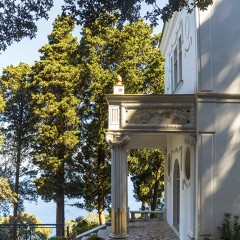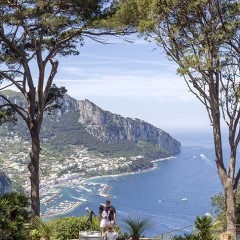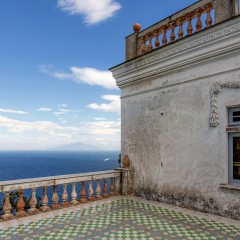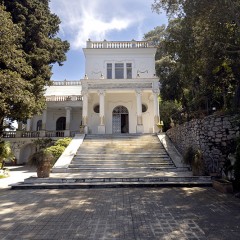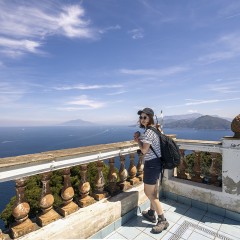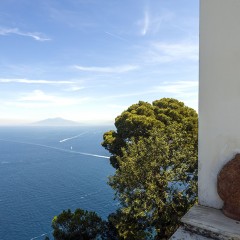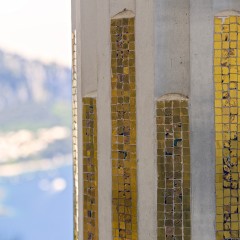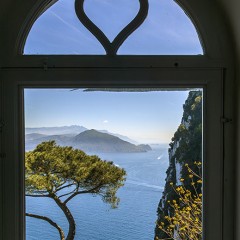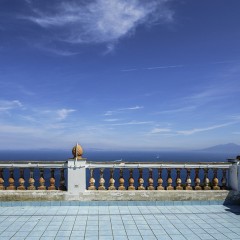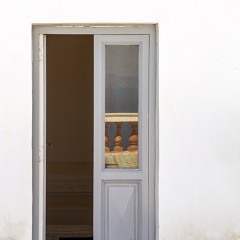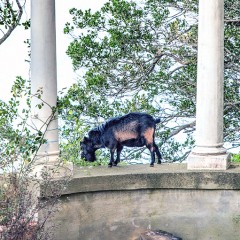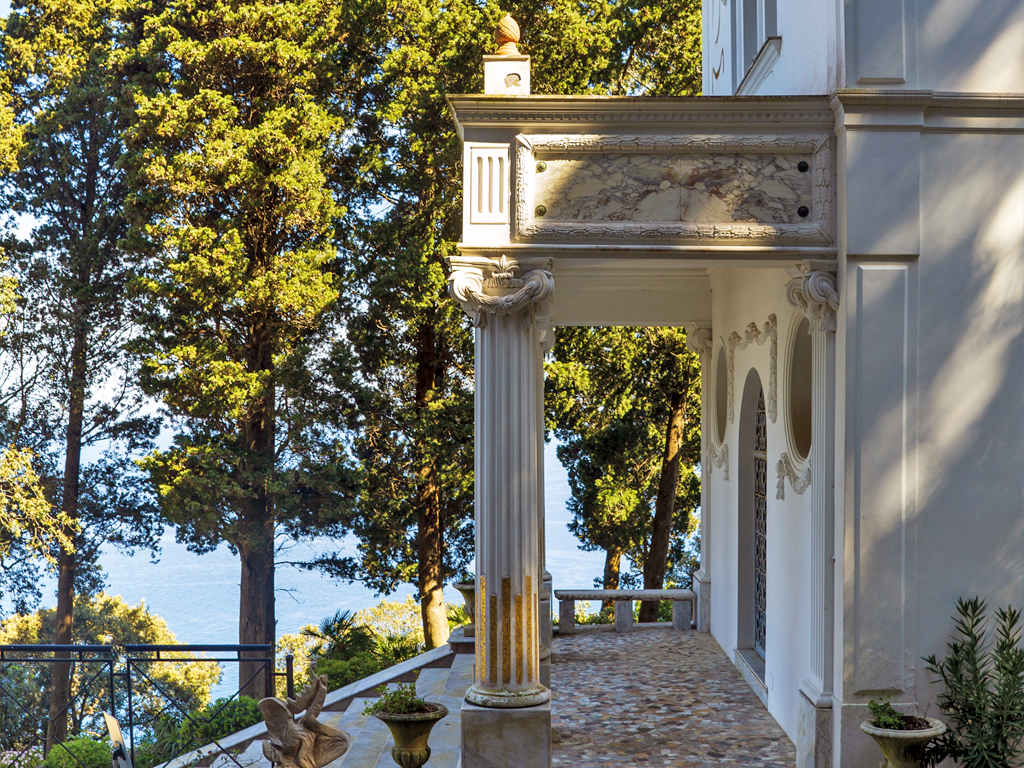
A casa del conte
Entriamo a Villa Lysis, luogo simbolo della vita e della passione di Jacques d’Adelsward-Fersen
di Marilena D’Ambro • foto di Raffaele Lello Mastroianni
 Il Novecento è appena iniziato e Jacques d’Adelsward-Fersen sceglie Capri per rifugiarsi dal mondo. È piena estate quando percorre via Tiberio con passi gentili ma decisi. Il portamento regale tradisce le sue origini nobiliari mentre il caldo sole di luglio illumina i suoi capelli biondi: i raggi scivolano sulla pelle bianca del viso e disegnano il profilo delicato di un giovane che ha ancora voglia di sognare e scrivere poesie.
Il Novecento è appena iniziato e Jacques d’Adelsward-Fersen sceglie Capri per rifugiarsi dal mondo. È piena estate quando percorre via Tiberio con passi gentili ma decisi. Il portamento regale tradisce le sue origini nobiliari mentre il caldo sole di luglio illumina i suoi capelli biondi: i raggi scivolano sulla pelle bianca del viso e disegnano il profilo delicato di un giovane che ha ancora voglia di sognare e scrivere poesie.
Supera via Lo Capo: ginestre in fiore si accendono come fiamme dorate lungo il sentiero costellato da case bianche e muretti a secco. Il profumo del rosmarino addolcisce l’atmosfera e placa il cuore in tumulto di quell’uomo in fuga da Parigi e dagli scandali. La sua colpa? Trascorre troppo tempo in compagnia di giovinetti organizzando pièce teatrali di dubbia morale.
Avvolto dal silenzio si lascia alle spalle ipocrisie e pregiudizi dell’alta società europea e continua la passeggiata attratto da un misterioso richiamo. Svolta a destra, prosegue per una stradina in salita e giunge in un immenso terreno a picco sul mare abbracciato da pini e cipressi che si allungano verso il cielo.
Qui sente l’anima vibrare. Capisce di aver trovato la sua casa, ancora non c’è ma i suoi occhi inafferrabili la vedono: Villa Lysis, dimora consacrata all’amore e al dolore, il luogo in cui resterà per sempre giovane.
Jacques è folgorato da quell’angolo di paradiso romantico e decadente sul versante nord orientale dell’isola. Così acquista dalla famiglia Salvia, per 15.000 lire, quel terreno di cui si è innamorato, una distesa di 12.000 metri quadrati e ne affida il progetto di costruzione all’amico Edouard Chimot, scenografo e incisore che gli propone una residenza in stile mediterraneo, con archi e tetti a cupola, ma lui desidera “qualcosa che non somigliasse a niente” e allo stesso tempo rispecchi il suo gusto classico.
Per i lavori di muratura, sotto consiglio di Donna Lucia Morgano, chiama mastro Vito. E per la realizzazione del parco-giardino si rivolge a Mimì Ruggiero incaricandolo di piantare narcisi, camelie, orchidee, mirti e allori in omaggio a Venere e Apollo. Poi, parte per un viaggio in Estremo Oriente. Al ritorno si reca a Napoli e Roma dove incontrerà l’amore della sua vita, Nino Cesarini.
Intanto, nel 1905, Villa Lysis viene completata. Concepita in stile Liberty, con influenze neogotiche e neoclassiche, deve il suo nome al dialogo platonico Liside – discepolo di Socrate – dedicato al tema dell’amicizia. L’ingresso è preceduto da quattro colonne ioniche decorate da tessere dorate e sull’architrave si legge l’iscrizione in latino “Amori et dolori sacrum”, titolo di un’opera di Maurice Barrès, che dà il benvenuto agli ospiti e incarna lo spirito con cui il suo proprietario visse questo luogo.
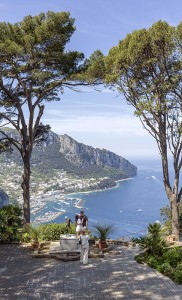 Intorno un giardino profumato si mostra in un tripudio di colori e accarezza un tempietto circolare. Basta un battito di ciglia per tornare nel passato: Jacques è fermo sulla soglia di quel tempio opalescente, simbolo di una Capri elegante, esoterica e pagana. La villa è stata spesso teatro di eventi legati alla poesia, alla letteratura e agli incontri, e negli ultimi anni è tornata ad essere palcoscenico di concerti, reading letterari, rappresentazioni teatrali. La scalinata che scende verso la terrazza appare come una naturale càvea dove prender posto e assistere agli spettacoli più belli. Tra tutti, il tramonto.
Intorno un giardino profumato si mostra in un tripudio di colori e accarezza un tempietto circolare. Basta un battito di ciglia per tornare nel passato: Jacques è fermo sulla soglia di quel tempio opalescente, simbolo di una Capri elegante, esoterica e pagana. La villa è stata spesso teatro di eventi legati alla poesia, alla letteratura e agli incontri, e negli ultimi anni è tornata ad essere palcoscenico di concerti, reading letterari, rappresentazioni teatrali. La scalinata che scende verso la terrazza appare come una naturale càvea dove prender posto e assistere agli spettacoli più belli. Tra tutti, il tramonto.
A far da quinta il panorama sul monte Solaro e il borgo marinaro di Marina Grande, su un piedistallo la statua di un pescatorello in posa.
Ovunque un’atmosfera a tratti malinconica e struggente, che ha assorbito appieno la personalità del suo proprietario originale. Una fusione di stili diversi in un’armonica simbiosi decreta la grande bellezza della villa.
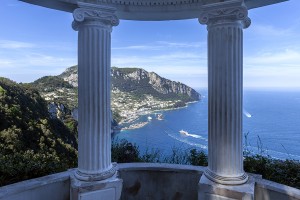 L’atrio è attraversato da una scala in marmo con una ringhiera in ferro battuto abbellita da pampini, un orgoglio di manifattura caprese. Sulla sinistra domina il salone in stile Luigi XVI – incorniciato dalla veranda rivestita da piastrelle azzurre con greche bianche – percorso da colonne e illuminato da finestre che ritagliano il blu del mare e del cielo. Un pianoforte solitario aspetta di prendere vita.
L’atrio è attraversato da una scala in marmo con una ringhiera in ferro battuto abbellita da pampini, un orgoglio di manifattura caprese. Sulla sinistra domina il salone in stile Luigi XVI – incorniciato dalla veranda rivestita da piastrelle azzurre con greche bianche – percorso da colonne e illuminato da finestre che ritagliano il blu del mare e del cielo. Un pianoforte solitario aspetta di prendere vita.
Al piano superiore, la camera che fu di Nino Cesarini si affaccia su una terrazza sospesa sul Golfo e lastricata da maioliche con motivi floreali. Poco dopo si entra nella stanza da letto di Fersen che termina ad esedra con tre finestre che affacciano sul Golfo di Napoli e tre sul Monte Tiberio. Lungo il corridoio si inseriscono la camera degli ospiti e la sala da pranzo. Nel seminterrato ci sono gli spazi che una volta erano riservati alla servitù e al fumoir.
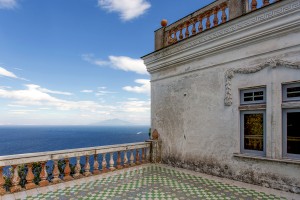 Lo scrittore Roger Peyrefitte – autore de L’esule di Capri, biografia romanzata del barone – così descrive l’ambiente della stanza: «Il soffitto basso, le rocce che affioravano in un angolo, creavano una strana impressione. Due colonne con liane isolavano una specie di patio illuminato da finestrelle con vetri gialli. Sulle pareti scintillavano iscrizioni cinesi a lettere d’oro». Il cerchio, la stella di David, il fiore di loto decorano l’architrave in alto. In basso, la svastica adorna il pavimento color ocra. Anche in questo ambiente fa capolino il motivo della greca che ricorre in ogni angolo della villa. Sono tutti simboli di rinascita, nuova vita e continuità. Sembra quasi di vederlo in quel luogo pregno di misticismo. Cerca di alleviare i suoi tormenti e recita versi dedicati all’isola: «Bambino come un tempo. Così voglio pensarmi: voglio quel cuore fidente e quel semplice animo. Guarderò le nuvole, nelle nuvole ancora. Col tuo miracolo azzurro, con la tua placidezza, scorderò gli empi che sono fra di noi, l’uomo egoista, avaro, indifferente e folle, la donna piegata dalla sottomissione».
Lo scrittore Roger Peyrefitte – autore de L’esule di Capri, biografia romanzata del barone – così descrive l’ambiente della stanza: «Il soffitto basso, le rocce che affioravano in un angolo, creavano una strana impressione. Due colonne con liane isolavano una specie di patio illuminato da finestrelle con vetri gialli. Sulle pareti scintillavano iscrizioni cinesi a lettere d’oro». Il cerchio, la stella di David, il fiore di loto decorano l’architrave in alto. In basso, la svastica adorna il pavimento color ocra. Anche in questo ambiente fa capolino il motivo della greca che ricorre in ogni angolo della villa. Sono tutti simboli di rinascita, nuova vita e continuità. Sembra quasi di vederlo in quel luogo pregno di misticismo. Cerca di alleviare i suoi tormenti e recita versi dedicati all’isola: «Bambino come un tempo. Così voglio pensarmi: voglio quel cuore fidente e quel semplice animo. Guarderò le nuvole, nelle nuvole ancora. Col tuo miracolo azzurro, con la tua placidezza, scorderò gli empi che sono fra di noi, l’uomo egoista, avaro, indifferente e folle, la donna piegata dalla sottomissione».
In the count’s house
We take a look inside Villa Lysis, a place that symbolizes the life and passions of Jacques d’Adelsward-Fersen
by Marilena D’Ambro • photos by Raffaele Lello Mastroianni
It is the beginning of the 20th century and Jacques d’Adelsward-Fersen has chosen Capri as the place to take refuge from the world. It is the height of summer when he walks along Via Tiberio with graceful but determined steps. His regal bearing betrays his aristocratic roots, while the hot July sun lights up his blond hair: the rays glide over the pale skin of his face, outlining the delicate profile of a young man who still longs to dream and to write poetry.
He passes Via Lo Capo: the broom is in flower, blazing like golden flames along the path dotted with white houses and dry stone walls. The scent of rosemary sweetens the air and calms the tumult in the heart of this young man as he flees from Paris and from scandal. His crime? To have spent too much time with a group of schoolboys, staging theatrical pieces of dubious morality.
Shrouded in silence, he leaves behind him the hypocrisy and prejudice of European high society and continues his walk, drawn by a mysterious allure. He turns right and climbs up a steep path until he reaches a huge expanse of land high above the sea, surrounded by pines and cypresses reaching towards the sky.
Here, he feels his soul quiver with excitement: he realises that he has found his house. It does not yet exist, but his impenetrable eyes can see it: Villa Lysis, a residence consecrated to love and pain, a place where you will stay for ever young.
Jacques was struck as if by lightning by this romantic and decadent corner of paradise on the north-eastern side of the island and so he bought the piece of land he had fallen in love with from the Salvia family for 15,000 lire. It was a plot measuring 12,000 square metres, and he entrusted the building project to his friend Edouard Chimot. Chimot, a stage designer and engraver, suggested building a villa in Mediterranean style, with arches and domed roofs, but Jacques wanted something that would be “different from anything else” but that would, at the same time, reflect his classical taste.
On the advice of Donna Lucia Morgano, he called on the master builder Vito to construct the house. And for the creation of the park-garden he turned to Mimì Ruggiero, entrusting him with the task of planting narcissus, camellias, orchids, myrtle and bay, in homage to Venus and Apollo. Then he set off on a journey to the Far East. On his return he visited Naples and Rome, where he met the love of his life, Nino Cesarini.
Meanwhile Villa Lysis had been completed in 1905. Designed in Liberty style, with neo-Gothic and neo-classical influences, it owes its name to the Platonic dialogue Lysis – a disciple of Socrates – on the theme of friendship. In front of the entrance are four Ionic columns decorated with golden mosaic pieces, with a Latin inscription on the architrave that reads “Amori et dolori sacrum”: it is the title of a work by Maurice Barrès, and greets guests arriving at the house, embodying the spirit which the owner felt to be in this place.
The house is surrounded by a garden full of scents and ablaze with colours, caressing a circular temple. In the bat of an eyelid we are back in the past and Jacques stands motionless on the threshold of that opalescent temple, symbol of an elegant, esoteric and pagan Capri. The villa has often been used to stage events connected with poetry, literature and meetings, and in the last few years it has again become a venue for concerts, literary readings and theatrical performances. The stairs leading down to the terrace are like a natural amphitheatre where people can sit and watch the most beautiful shows. Best of all, the sunset.
Forming the backdrop is the panorama of Monte Solaro and the seaside village of Marina Grande, with the statue of a fisher-boy poised on a pedestal.
The atmosphere all around is poignant and melancholic at times, having fully absorbed the personality of its original owner. The fusion of different styles in a harmonious symbiosis is what makes the villa so beautiful.
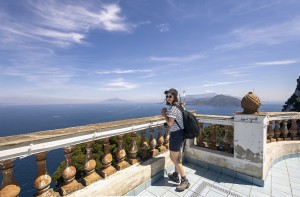 A marble staircase leads up from the atrium, with a wrought iron balustrade featuring decorative vine leaves, a proud piece of Capri craftsmanship. On the left is the salon in Louis XVI style, framed by a veranda paved with blue tiles with a white Greek-key motif border; the salon is dotted with columns and illuminated by windows that seem to crop the deep blue of the sea and sky. A solitary piano waits to be brought to life.
A marble staircase leads up from the atrium, with a wrought iron balustrade featuring decorative vine leaves, a proud piece of Capri craftsmanship. On the left is the salon in Louis XVI style, framed by a veranda paved with blue tiles with a white Greek-key motif border; the salon is dotted with columns and illuminated by windows that seem to crop the deep blue of the sea and sky. A solitary piano waits to be brought to life.
On the upper floor, the room that was Nino Cesarini’s bedroom opens onto a terrace suspended over the Gulf of Naples, and paved with majolica tiles with floral motifs. Just after that is Fersen’s bedroom which ends in an exedra with three windows overlooking the Gulf and three looking onto Monte Tiberio. Along the corridor is the guest bedroom and the dining-room. The basement houses the spaces that were once the servants’ quarters and the fumoir, or smoking room.
The writer Roger Peyrefitte – author of a fictionalized biography of the Baron, The Exile of Capri – describes the atmosphere of the smoking room: “The low ceiling, the rocks emerging in a corner, created a strange impression. Two columns with lianas separated the room from a kind of patio illuminated by windows with yellow glass panes. Chinese inscriptions in gold lettering glittered on the walls.” Up on the architrave there is a circle, a star of David and a lotus flower, while down below a swastika adorns the ochre-coloured floor. The Greek key motif that features in every corner of the villa makes an appearance in this room, too. All of these are symbols of rebirth, new life and continuity. You feel almost as if you can see Fersen in this place, so imbued with mysticism. He is trying to assuage his suffering, and is reciting poetry dedicated to the island: “A child, as I once was. That’s how I like to think of myself: I want to have that trusting heart and that simple spirit. I will gaze at the clouds, be among the clouds again. With your miraculous blue, your peacefulness, I will forget the cruel people among us, the egoists, the mean, the indifferent and the stupid, the woman bent in submission.”
Una realtà eterna
 Amano, promuovono e tutelano Villa Lysis. Sono i soci di Ápeiron, l’associazione che è tornata a far risplendere uno dei gioielli più preziosi dell’isola dopo aver vinto il bando di gara indetto dall’amministrazione comunale per la gestione della casa-museo. L’associazione vanta una lunga esperienza nella direzione del monumento, ne ha sancito la riscoperta e la rinascita, ha ridato alla storica dimora un’identità definita e l’ha trasformata in un appuntamento imperdibile per i residenti e in un polo d’attrazione internazionale per viaggiatori e intellettuali. Ha ideato e organizzato eventi culturali di spessore con reading e spettacoli dedicati alla poesia, alla musica e alla danza, e anche quest’anno si preannuncia ricco di incontri e di rappresentazioni teatrali in collaborazione con compagnie note a livello nazionale.
Ápeiron è riuscita a raccogliere e custodire l’eredità di Fersen rendendo la villa partecipata e vitale. L’ingrediente segreto? L’amore infinito dei soci per la terra natia. D’altro canto, è questo il significato del nome Ápeiron: “illimitato”, “infinito” e rappresenta, secondo la filosofia di Anassimandro, il principio di una realtà eterna, indistruttibile e in continuo mutamento. | An eternal reality.
They love, promote and protect Villa Lysis: ‘they’ are the members of Ápeiron, the association that has brought one of the most precious treasures of the island back to its former splendour, after winning the tender launched by the local authority for managing the house-museum. The association has had long experience in managing the monument: it planned and worked out its rediscovery and rebirth, and has restored a clear identity to the historic residence, transforming it into a must-see for residents and into an international attraction for travellers and intellectuals. It has planned and organized major cultural events with readings and shows dedicated to poetry, music and dance; this year, too, there will be a wide range of events and stage shows in collaboration with well-known companies at a national level.
Ápeiron has managed to bring together and preserve Fersen’s legacy, making the villa something alive, something to be shared. So what is the secret ingredient? The members’ infinite love for their native land. That’s what Ápeiron means, after all: “unlimited”, “infinite”, representing, according to Anaximander’s philosophy, the principle of an eternal reality that is indestructible and continually changing.
Amano, promuovono e tutelano Villa Lysis. Sono i soci di Ápeiron, l’associazione che è tornata a far risplendere uno dei gioielli più preziosi dell’isola dopo aver vinto il bando di gara indetto dall’amministrazione comunale per la gestione della casa-museo. L’associazione vanta una lunga esperienza nella direzione del monumento, ne ha sancito la riscoperta e la rinascita, ha ridato alla storica dimora un’identità definita e l’ha trasformata in un appuntamento imperdibile per i residenti e in un polo d’attrazione internazionale per viaggiatori e intellettuali. Ha ideato e organizzato eventi culturali di spessore con reading e spettacoli dedicati alla poesia, alla musica e alla danza, e anche quest’anno si preannuncia ricco di incontri e di rappresentazioni teatrali in collaborazione con compagnie note a livello nazionale.
Ápeiron è riuscita a raccogliere e custodire l’eredità di Fersen rendendo la villa partecipata e vitale. L’ingrediente segreto? L’amore infinito dei soci per la terra natia. D’altro canto, è questo il significato del nome Ápeiron: “illimitato”, “infinito” e rappresenta, secondo la filosofia di Anassimandro, il principio di una realtà eterna, indistruttibile e in continuo mutamento. | An eternal reality.
They love, promote and protect Villa Lysis: ‘they’ are the members of Ápeiron, the association that has brought one of the most precious treasures of the island back to its former splendour, after winning the tender launched by the local authority for managing the house-museum. The association has had long experience in managing the monument: it planned and worked out its rediscovery and rebirth, and has restored a clear identity to the historic residence, transforming it into a must-see for residents and into an international attraction for travellers and intellectuals. It has planned and organized major cultural events with readings and shows dedicated to poetry, music and dance; this year, too, there will be a wide range of events and stage shows in collaboration with well-known companies at a national level.
Ápeiron has managed to bring together and preserve Fersen’s legacy, making the villa something alive, something to be shared. So what is the secret ingredient? The members’ infinite love for their native land. That’s what Ápeiron means, after all: “unlimited”, “infinite”, representing, according to Anaximander’s philosophy, the principle of an eternal reality that is indestructible and continually changing.
Una vita di amori, vizi e virtù
Jacques d’Adelsward-Fersen nasce a Parigi il 20 febbraio 1880 – poeta, romanziere, omosessuale militante e ultimo principe dei dandy – visse per trasformare la sua vita in opera d’arte. Erede di una fiorente industria dell’acciaio, a 22 anni il giovane rampollo è già ricchissimo e vanta antenati illustri nel ramo paterno. Accolto con tutti gli onori nell’alta società, si infatua di Blanche, figlia del visconte di Moupeou con cui si fidanza. Si trasferisce in una nuova casa al 18 di avenue de Friedland in cerca di solitudine e maggiore libertà e qui, in compagnia di giovani studenti, organizza i cosiddetti tableaux-vivants, rappresentazioni teatrali di scene mitologiche che lui, più tardi, chiamerà messe rosa per il loro contenuto innocente ma lievemente audace.
Sarà presto travolto dallo scandalo: nel 1903 viene accusato di organizzare messe nere che degenerano in atti sessuali illeciti. In poco tempo l’aura di perfezione che circonda la sua figura si dissolve e si trova ad affrontare un processo che lo segnerà in modo indelebile. Quando il suo fidanzamento naufraga parte verso Capri con la speranza di poter ricominciare a vivere.
Una volta sbarcato alloggia a villa La Certosella, in via Tragara, ed entra in contatto con i residenti stranieri che considerano Capri il buen retiro per eccellenza. Coltiva un’amicizia profonda con gli scrittori Norman Douglas e Gilbert Clavel, le sorelle Wolcott-Perry, la principessa Ephy Lovatelli e la marchesa Casati Stampa.
Decide di far costruire Villa Lysis, poi parte per l’Estremo Oriente. A Ceylon resta affascinato dalla cultura locale: si avvicina a buddismo e induismo e scopre l’oppio; ammaliato dal senso di abbandono che provoca ne sarà dipendente per tutta la vita.
Al ritorno incontrerà a Roma Nino Cesarini. I suoi occhi neri e profondi rapiscono Jacques, in lui trova quell’ideale di bellezza pura che incendia mente e cuore. Il ragazzo accetta di partire con lui alla scoperta dell’incanto azzurro. Qui Fersen gli dà un’educazione e agli ospiti lo presenta come suo segretario. Attraversato da un fervente entusiasmo pubblica Lord Lyllian, romanzo autobiografico in cui ripercorre le vicende dello scandalo di Parigi. È uno scrittore prolifico, tra le sue opere più significative 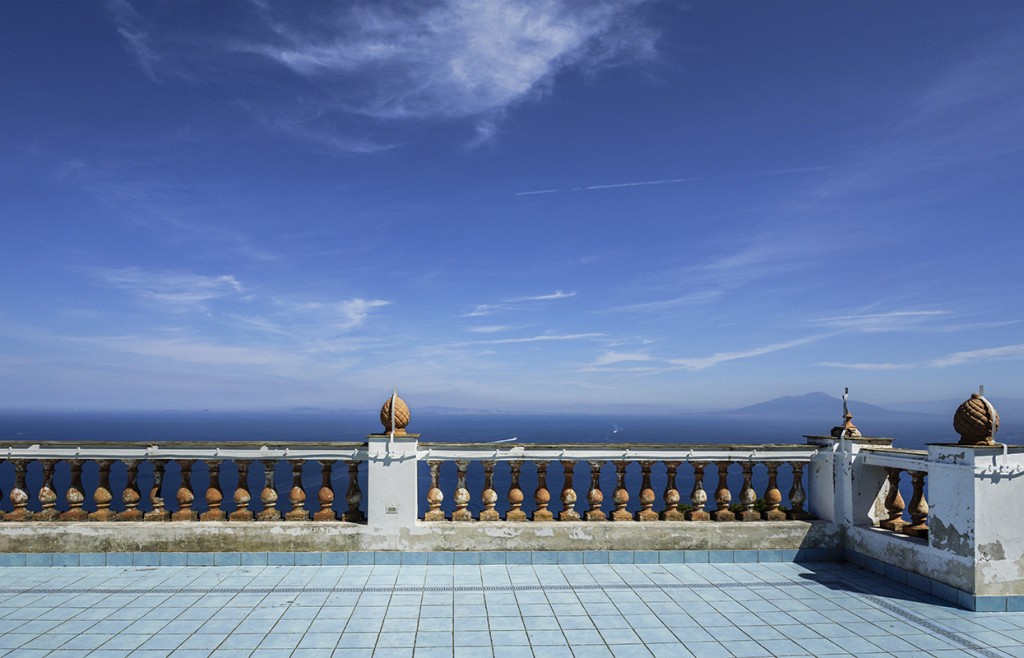 troviamo anche: E il fuoco si spense sul mare e Nostra signora dei mari morti.
L’idillio con Nino si interrompe quando il ragazzo è chiamato alle armi. Fersen non sopporta il distacco, si aggira come un fantasma tra le stanze vuote della villa e si abbandona al consumo di stupefacenti per lenire la sua ossessione.
La situazione non migliora quando torna dalla guerra. Non è più un fanciullo ma un uomo maturo disposto a offrire solo un’amicizia anche se non smette mai di vegliare sull’ex amante, forse, spera di salvarlo da una profezia già scritta. La sera del 7 novembre 1923 si consuma la tragedia: Fersen si ritira nella camera dell’oppio e beve un mix micidiale di cocaina e champagne. Un gesto premeditato? Forse sì, forse no. Così, all’età di 43 anni, Jacques saluta la vita e si consegna al mito dell’eterna giovinezza. | A life of loves, vices and virtues. Jacques d’Adelsward-Fersen was born in Paris on 20 February 1880: a poet, novelist, militant homosexual and the last prince of the dandies, he lived to transform his life into a work of art. He was the heir to a flourishing steel industry business, and at 22 years old, this young nobleman was already extremely wealthy and could boast illustrious ancestors on his father’s side. Greeted as an important guest of honour in high society, he became infatuated with Blanche, the daughter of the Viscount de Moupeou and they became engaged. He moved into a new house at number 18 Avenue de Friedland seeking solitude and greater freedom, and it was here that in the company of some schoolboys, he organized the so-called tableaux-vivants, theatrical stagings of mythological scenes, which he would later call ‘pink masses’ because of their innocent but rather risqué content.
troviamo anche: E il fuoco si spense sul mare e Nostra signora dei mari morti.
L’idillio con Nino si interrompe quando il ragazzo è chiamato alle armi. Fersen non sopporta il distacco, si aggira come un fantasma tra le stanze vuote della villa e si abbandona al consumo di stupefacenti per lenire la sua ossessione.
La situazione non migliora quando torna dalla guerra. Non è più un fanciullo ma un uomo maturo disposto a offrire solo un’amicizia anche se non smette mai di vegliare sull’ex amante, forse, spera di salvarlo da una profezia già scritta. La sera del 7 novembre 1923 si consuma la tragedia: Fersen si ritira nella camera dell’oppio e beve un mix micidiale di cocaina e champagne. Un gesto premeditato? Forse sì, forse no. Così, all’età di 43 anni, Jacques saluta la vita e si consegna al mito dell’eterna giovinezza. | A life of loves, vices and virtues. Jacques d’Adelsward-Fersen was born in Paris on 20 February 1880: a poet, novelist, militant homosexual and the last prince of the dandies, he lived to transform his life into a work of art. He was the heir to a flourishing steel industry business, and at 22 years old, this young nobleman was already extremely wealthy and could boast illustrious ancestors on his father’s side. Greeted as an important guest of honour in high society, he became infatuated with Blanche, the daughter of the Viscount de Moupeou and they became engaged. He moved into a new house at number 18 Avenue de Friedland seeking solitude and greater freedom, and it was here that in the company of some schoolboys, he organized the so-called tableaux-vivants, theatrical stagings of mythological scenes, which he would later call ‘pink masses’ because of their innocent but rather risqué content.
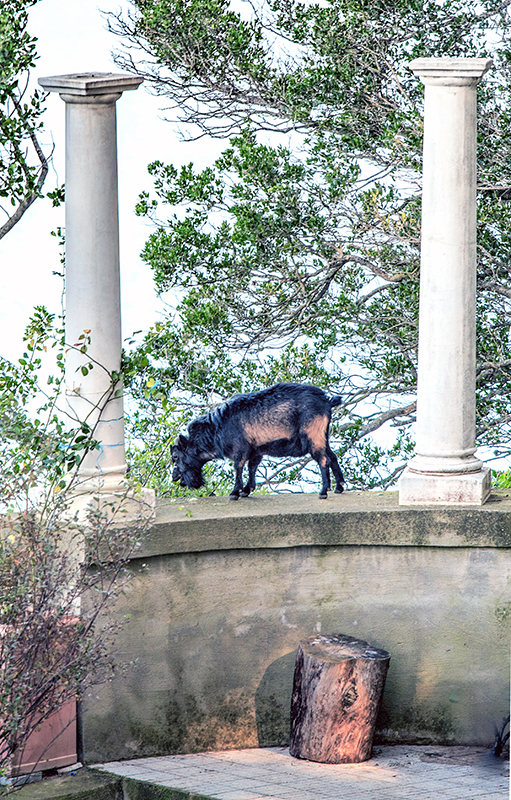 He was soon swept up in scandal: in 1903 he was accused of organizing black masses which degenerated into illicit sexual acts. The aura of perfection that had surrounded him quickly dissolved and he had to undergo a trial which was to leave an indelible mark on him. When his engagement broke up, Fersen left for Capri in the hope that he could begin life again there.
After arriving on Capri, he stayed in the villa La Certosella, in Via Tragara, and made contact with the foreign residents who considered Capri to be the ‘beautiful retreat’ par excellence. He cultivated a close friendship with the writers Norman Douglas and Gilbert Clavel, the Wolcott-Perry sisters, Princess Ephy Lovatelli and the Marchesa Casati Stampa.
He decided to embark on building Villa Lysis, and then left for the Far East.
In Ceylon, he was fascinated by the local culture: he became interested in Buddhism and Hinduism and discovered opium; bewitched by the sense of abandonment that it brought, he became dependent on it for the rest of his life.
On his return, he went to Rome, where he met Nino Cesarini. Jacques was entranced by his deep, dark eyes, finding in him that ideal of pure beauty that set his mind and heart aflame. Nino agreed to leave with Fersen to discover the blue magic of Capri. Here Fersen gave him an education and presented him to his guests as his secretary. Gripped by a fervent enthusiasm, Fersen published Lord Lyllian, an autobiographical novel in which he describes the events of the Paris scandal. He was a prolific writer: his more important works include: And the Fire was Smothered by the Sea and Our Lady of the Dead Seas.
The idyll with Nino was interrupted when the boy was called up for military service. Fersen could not bear the separation, and wandered like a ghost among the empty rooms of the villa, surrendering himself to narcotics to soothe his obsession.
The situation did not improve when Nino returned from the war. He was no longer an adolescent, but a grown man who would only offer his friendship, although he never ceased to look after his former lover: perhaps he hoped to save him from a prophecy that was already written. The tragedy reached its end on the evening of 7 November 1923: Fersen withdrew to his opium-smoking room and drank a fatal mixture of cocaine and champagne. Was it a premeditated action? Perhaps, perhaps not. Thus, at the age of 43, Jacques bid farewell to life and surrendered himself to the myth of eternal youth.
He was soon swept up in scandal: in 1903 he was accused of organizing black masses which degenerated into illicit sexual acts. The aura of perfection that had surrounded him quickly dissolved and he had to undergo a trial which was to leave an indelible mark on him. When his engagement broke up, Fersen left for Capri in the hope that he could begin life again there.
After arriving on Capri, he stayed in the villa La Certosella, in Via Tragara, and made contact with the foreign residents who considered Capri to be the ‘beautiful retreat’ par excellence. He cultivated a close friendship with the writers Norman Douglas and Gilbert Clavel, the Wolcott-Perry sisters, Princess Ephy Lovatelli and the Marchesa Casati Stampa.
He decided to embark on building Villa Lysis, and then left for the Far East.
In Ceylon, he was fascinated by the local culture: he became interested in Buddhism and Hinduism and discovered opium; bewitched by the sense of abandonment that it brought, he became dependent on it for the rest of his life.
On his return, he went to Rome, where he met Nino Cesarini. Jacques was entranced by his deep, dark eyes, finding in him that ideal of pure beauty that set his mind and heart aflame. Nino agreed to leave with Fersen to discover the blue magic of Capri. Here Fersen gave him an education and presented him to his guests as his secretary. Gripped by a fervent enthusiasm, Fersen published Lord Lyllian, an autobiographical novel in which he describes the events of the Paris scandal. He was a prolific writer: his more important works include: And the Fire was Smothered by the Sea and Our Lady of the Dead Seas.
The idyll with Nino was interrupted when the boy was called up for military service. Fersen could not bear the separation, and wandered like a ghost among the empty rooms of the villa, surrendering himself to narcotics to soothe his obsession.
The situation did not improve when Nino returned from the war. He was no longer an adolescent, but a grown man who would only offer his friendship, although he never ceased to look after his former lover: perhaps he hoped to save him from a prophecy that was already written. The tragedy reached its end on the evening of 7 November 1923: Fersen withdrew to his opium-smoking room and drank a fatal mixture of cocaine and champagne. Was it a premeditated action? Perhaps, perhaps not. Thus, at the age of 43, Jacques bid farewell to life and surrendered himself to the myth of eternal youth.
Per saperne di più
 Eccentrico, singolare, eccessivo. Jacques d’Adelswärd Fersen era tutto questo e anche molto di più. Su di lui le cronache del suo tempo hanno speso fiumi di parole e dopo di lui l’interesse di scrittori e intellettuali non è venuto meno.
Sono tanti i libri pubblicati che ne hanno raccontato l’opera, la vita, le stravaganze e le sregolatezze. Che sia una biografia romanzata o la prima raccolta di poesie del conte tradotte in italiano, ogni libro riesce a tracciare un ritratto accurato e mai banale di Fersen e del suo legame con l’isola che lo ha accolto e protetto.
Proprio Capri può essere considerata il fil rouge e la co-protagonista di tutte le storie che ruotano intorno a questo personaggio, un microcosmo prodigioso in grado di creare legami indissolubili che vanno oltre i confini del tempo. | For more information.. Eccentric, peculiar, excessive. Jacques d’Adelswärd Fersen was all these things and much more. The news articles of his time devoted pages to him and after his death writers and intellectuals continued to be fascinated by him.
Many books have been published about his work, his life, his eccentricity and his profligacy. Whether it is the fictionalized biography or the Count’s first collection of poetry translated into Italian, each book manages to sketch a detailed but never banal portrait of Fersen and his bond with the island that welcomed and protected him.
Capri may be considered the leitmotif and co-protagonist of all the stories that gravitate around this character: an incredible microcosm, able to create indissoluble bonds that go beyond the limits of time.
Eccentrico, singolare, eccessivo. Jacques d’Adelswärd Fersen era tutto questo e anche molto di più. Su di lui le cronache del suo tempo hanno speso fiumi di parole e dopo di lui l’interesse di scrittori e intellettuali non è venuto meno.
Sono tanti i libri pubblicati che ne hanno raccontato l’opera, la vita, le stravaganze e le sregolatezze. Che sia una biografia romanzata o la prima raccolta di poesie del conte tradotte in italiano, ogni libro riesce a tracciare un ritratto accurato e mai banale di Fersen e del suo legame con l’isola che lo ha accolto e protetto.
Proprio Capri può essere considerata il fil rouge e la co-protagonista di tutte le storie che ruotano intorno a questo personaggio, un microcosmo prodigioso in grado di creare legami indissolubili che vanno oltre i confini del tempo. | For more information.. Eccentric, peculiar, excessive. Jacques d’Adelswärd Fersen was all these things and much more. The news articles of his time devoted pages to him and after his death writers and intellectuals continued to be fascinated by him.
Many books have been published about his work, his life, his eccentricity and his profligacy. Whether it is the fictionalized biography or the Count’s first collection of poetry translated into Italian, each book manages to sketch a detailed but never banal portrait of Fersen and his bond with the island that welcomed and protected him.
Capri may be considered the leitmotif and co-protagonist of all the stories that gravitate around this character: an incredible microcosm, able to create indissoluble bonds that go beyond the limits of time.







